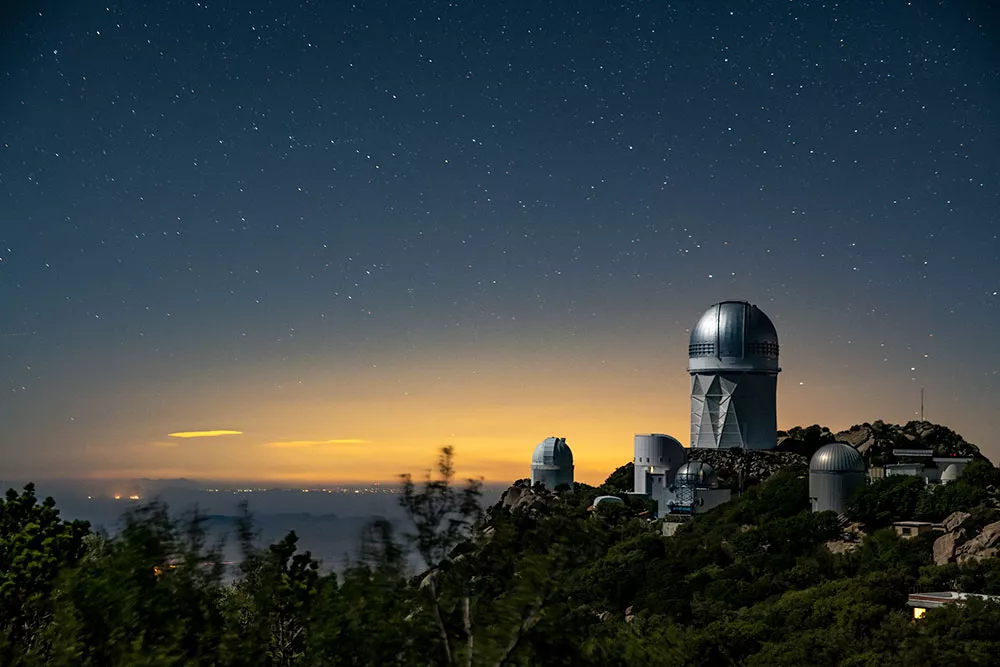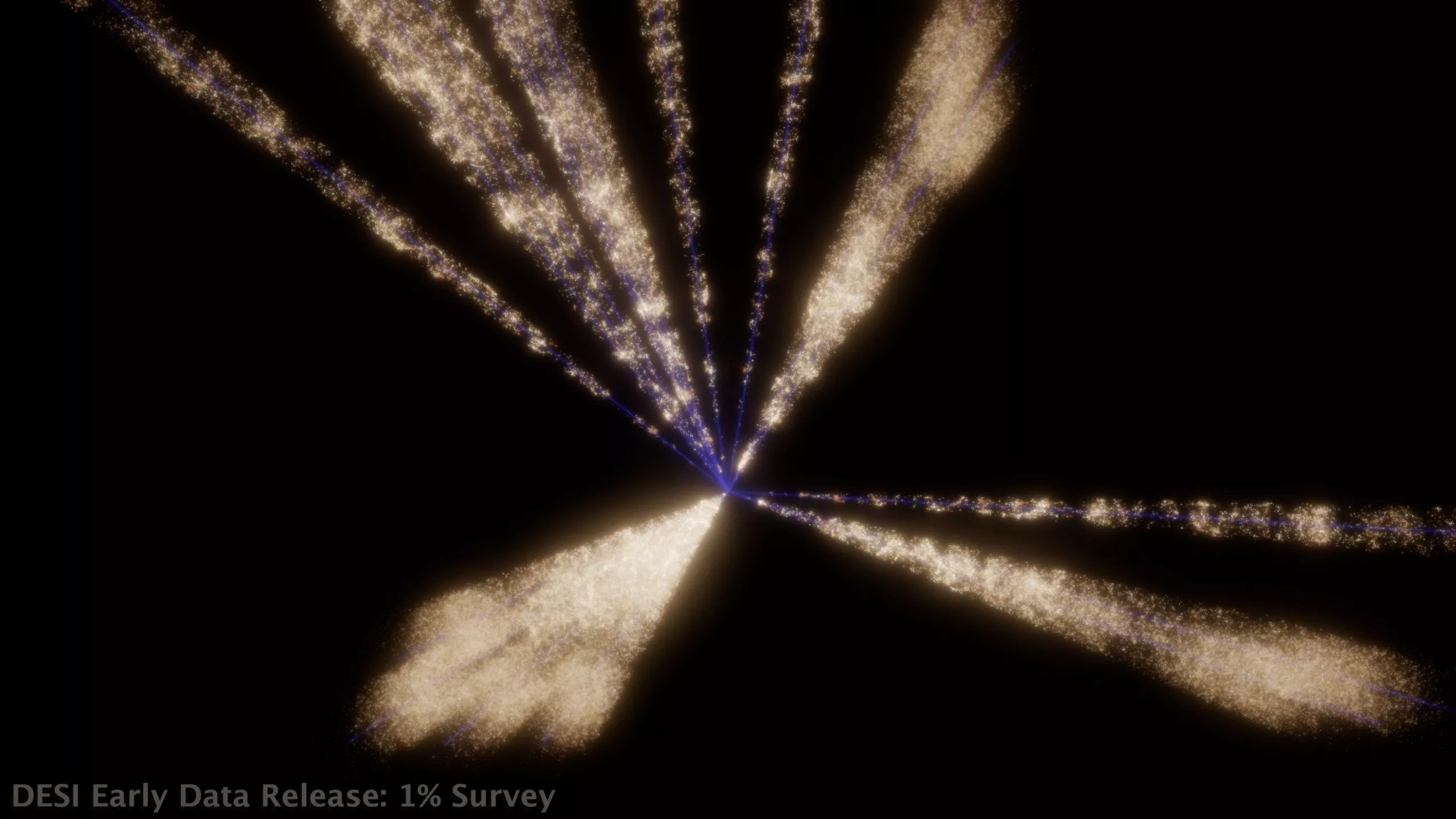The accelerating cosmic expansion of the universe can be associated with the mysterious dark energy that fills approximately 70 percent of the universe. This dark energy is now being mapped by astronomers using the Dark Energy Spectroscopic Instrument (DESI) in an international collaboration. In this five-year project, researchers are examining a total of nearly 40 million galaxies, quasars, and stars. Recently, the collaboration unveiled the data for the first 2 million objects. András Kovács, research fellow at the Konkoly Thege Miklós Astronomical Institute of the ELKH Research Centre for Astronomy and Earth Sciences (CSFK) and leader of the Momentum research group operating within the institute, also participated in the verification of the data.
As the universe expands, the wavelength of light traveling through it also stretches, shifting them to become more and more red. This phenomenon is commonly referred to as cosmological redshift. The further a galaxy is observed, the greater the redshift, and determining its precise value by recording the optical spectra is a time-consuming and instrument-intensive process. Following the less precise but wide-ranging photometric estimations carried out with a few color filters such as the Dark Energy Survey and KiDS, and more precise spectroscopic programs surveying smaller portions of the sky like GAMA and VIPERS, the DESI project specializes in combining the advantages of these approaches to collect redshift data with high precision from a significant portion of the sky. Researchers can then utilize this data to tackle the greatest mysteries of cosmology, including the nature of dark energy and its evolution throughout the history of the universe (Image 1).

Image 1: The DESI instrument was installed on the 4-meter Mayall Telescope at the Kitt Peak National Observatory in Arizona, and the project is coordinated by the Lawrence Berkeley National Lab (LBNL)
in California
(Credit: Marilyn Sargent/Berkeley Lab)
The 80-terabyte dataset, which was verified with the participation of András Kovács, originates from 2480 exposures taken during a six-month period of the test phase of sky survey conducted in 2020 and 2021. Between the installation of the DESI spectrograph in Arizona, USA, and the commencement of the official scientific process, researchers ensured that the telescope's operational plan aligns with the scientific objectives. Among others, they also verified the time required for observing galaxies of different brightness and confirmed the selection of galaxies to be observed in more detail.
“The fact that DESI works so well, and that the amount of science-grade data it took during survey validation is comparable to previous completed sky surveys, is a monumental achievement,” said Nathalie Palanque-Delabrouille, co-spokesperson for DESI and a scientist at the Department of Energy’s Lawrence Berkeley National Laboratory (Berkeley Lab), which manages the experiment. “This milestone shows that DESI is a unique spectroscopic factory whose data will not only allow the study of dark energy but will also be coveted by the whole scientific community to address other topics, such as dark matter, gravitational lensing, and galactic morphology.”
The DESI instrument utilizes 5000 robot positioners to move optical fibers, which capture the light from objects located millions or billions of light-years away. This is the world's most powerful multi-object spectrograph for sky surveys, capable of measuring the light of over 100,000 galaxies in a single night. The details of the incoming light’s spectrum provide information to the researchers about the distance of the object through its redshift, allowing for the creation of a three-dimensional cosmic map of the distribution of matter around the Milky Way, even on scales of billions of light-years.
One key element of the survey's testing phase was the development of identification software that automatically classifies the spectra of tens of millions of stars, galaxies, and quasars over the next five years.
"In the testing phase of the survey, we visually inspected the quality of thousands of observed DESI spectra and the classification of observations for stars, bright galaxies, and distantly visible active galactic nuclei, also called quasars," said András Kovács. "We managed to optimize the classification algorithms and reaffirm the DESI observation strategy. From the perspective of my own research, the map of distant regions of the cosmic web revealed by quasars will be particularly interesting. It can aid in identifying the most extreme superclusters in the universe, exploring an era when the universe was only a quarter of its current age," added the researcher.
The collaboration has published scientific articles related to preliminary data release, which include early statistical measurements of galaxy clustering, the study of rare quasars, as well as descriptions of telescope operation and survey plans. There is still a significant amount of data expected from the experiment, as the DESI is currently in its second year of a five-year duration. Progressing faster than anticipated, the survey has already classified over 26 million astrophysical objects since the start of the sharp data collection, with the list expanding by over one million additional objects each month (Image 2).

Image 2: During the DESI project, a 3D map of the universe is being created (the figure shows the existing 1%) to better understand the parameters of dark energy responsible for the accelerating expansion
(Credit: David Kirkby/DESI collaboration)
The exceptional spectroscopic dataset generated by DESI not only contributes to understanding cosmological mysteries but also provides a wealth of information for studying the properties of supermassive black holes at the centers of galaxies, investigating the formation and evolution of galaxies, and mapping the material between stars and galaxies. Additionally, it contributes to the development of a new generation of scientists.
The DESI project is supported by the U.S. Department of Energy ‒ Office of Science, National Energy Research Scientific Computing Center, U.S. National Science Foundation, Science and Technologies Facilities Council (United Kingdom), Gordon and Betty Moore Foundation, Heising-Simons Foundation, French Alternative Energies and Atomic Energy Commission (CEA), as well as the DESI member institutions. The DESI collaboration considers it a great honor to conduct scientific research on the Iolkam Du'ag (Kitt Peak) mountain, which holds special significance for the Tohono O'odham Nation.